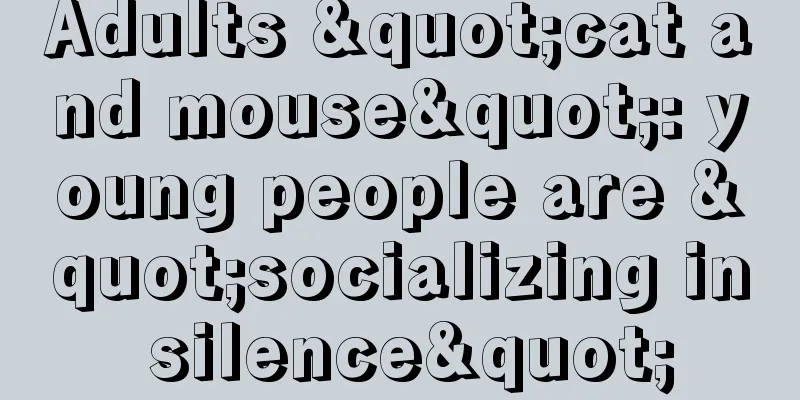Adults "cat and mouse": young people are "socializing in silence"

The adult "cat and mouse" game that costs 9.9 yuan or 19.9 yuan to play for an entire night is quietly becoming popular among young people. Taking the Chengdu "Not So Fun" gaming community as an example, within 30 days, the community grew from only 13 participants in the first game to four games every night, with 100 people in each game (the upper limit of the Gaode Map group is 100 people), and the total gaming community size approached 15,000 people. This may be a social method that has quickly become popular among young people after Frisbee, cycling, hiking in the suburbs, and city walking. (According to Red Star News: At the beginning of September, a new type of "hide and seek" game swept across the country. According to incomplete statistics, more than 50 cities including Beijing, Shanghai, Guangzhou, Shenzhen, Chengdu, Chongqing, Suzhou and Hangzhou) Cat and Mouse was born in the trend of young people gradually shifting from Internet group social interaction to simple offline social interaction. In the past few years, after leaving the campus environment, new white-collar workers, whose offline stranger interpersonal communication mode has quickly dried up, are eager to return to contact but are in urgent need of content. After the popularity of script-killing offline social interaction with relatively high language complexity, simple social interactions such as frisbee, cycling, hiking in the suburbs, and city walks, which focus more on the environment and weaken language communication, were born. Until the birth and popularity of games such as Cat and Mouse, this pursuit of low-communication social interaction has finally evolved to a limit, namely "silent social interaction." 1. Cat and mouse: just run in the darkThe cat-and-mouse activities usually take place at 7:30 pm in parks and on weekday evenings. If we follow the naming method of city walk, we would like to call it "city run". (Cat catching mouse in Chengdu Jincheng Lake Park) Participants arrived to receive a fluorescent wristband and a ribbon for participation certification. By default, all participants are mice. Open Gaode Map and change the avatar to the "mouse" avatar provided by the organization. The basic safety precautions and rules were explained. The rules basically only limited the activity area, you cannot stay in the toilet, you cannot climb trees, and basically you must move within the range visible from the ground. After the rules are explained, everyone will enter the Gaode group leader of the event that night and must share their location during the event. The "cat" generated by drawing lots or shaking dice (the map avatar is set to a "cat" and holds a glow stick as a prop) must wait for 10 minutes after the mice disperse from the activity site before setting out to "catch mice." The cat will come out at the appointed time and the activity will officially begin. As a mouse, you can see the distance between you and the cat at any time through the group positioning function on the map. You can choose to stay away from the cat or bypass it. After the mouse is caught by the cat (usually by lightly touching the mouse's body with a glow stick), it hands over the bandages on its hand and becomes the cat's trophy. The mouse also becomes the cat in the cat map group avatar setting and starts catching mice. At the end of the event, three prizes are usually awarded: Cat King: the person who has seized the most ribbons, Rat King: the person who is caught the latest or has not been caught at the end of the event, and Sports King: the person who has taken the most steps that night. The prizes are very simple: dolls, pillows, bracelets, water bottles, and even a more humorous scratch card. We found that most people who participated in the game were silent throughout the whole process. They just ran in the dark, looking for and completing social possibilities in this simple game mechanism itself. 2. The other side of “silent social interaction”“I just don’t want to talk to anyone after get off work at night,” Xiao Zeng, who works at Chengdu Global Center (nicknamed “Telemarketing Building” by netizens), said this when he started to like this game. Her work standard is to work from 9 am to 6 pm every day and make 200 sales calls, and she gets through it by being constantly rejected, actively explaining, and patiently guiding. "It's about 20 minutes' walk from the Global Center. I got off work at 6 o'clock and walked here after lunch, just in time for the event to start. It took about an hour and a half to wait for the event to end, which was around 9 o'clock. I took the subway back around 10 o'clock, and the whole night passed like this." Because she doesn't want to talk after get off work, she basically chooses to be "alone". Although this game involves more than 100 people, the magic for her is that being in an environment with more than 100 people, "silence" does not bring embarrassment. "I have faced more than 100 people, but I don't need to take the initiative to speak. This feeling is so refreshing." Compared with other social activities that she "tries to integrate into", she has no social pressure. She can be "silent" in the crowd for the entire event or consecutive airports. She has participated in 5 events, and the total number of times she has been caught and caught is almost 200 people. The total number of times she has spoken to people does not exceed 10 times. This and the feeling of having to talk to 200 people every day (her company's telemarketing connection rate is 200 times/day) make her feel unprecedented "liberation". "Here, among 200 people, she can be just herself, and she can also be one person." The pressure of having to talk to 200 people every day made her choose a social interaction where she "doesn't want to talk". But in the past social model, if you don't talk, you basically can't socialize, because even the simple social interaction of city walk is not "no need to talk" for Xiao Zeng. But the "silent social interaction" of cat and mouse provides the possibility of participating in games and completing social interactions without the premise of "having to talk". Cat and mouse can identify "same kind" mice without using language, and can also complete the "comradeship" of someone falling and supporting each other, or it can also stage the prequel of the pure love story of "I hold you, you run first". Although Xiao Zeng chose to be silent or "only say a few words" in every one of the many games she participated in, she also had her own social moments. "A boy who wears glasses and lives next to the Wuhou Temple took the initiative to lend me his power bank after hearing the sound of my phone running out of 20% battery." Maybe it’s because it’s quieter at night, or because “there aren’t that many people talking.” The sound of the 20% battery remaining is clearer, thus completing the “social moment” without talking. 3. Primitive stimulation, no words neededHow does silence bring about a sense of social interaction? Just like the seemingly meaningless chasing and fighting in elementary school was also an effective form of social interaction, the sense of relationship between people and even intimate trust can be built on the interaction in a tense psychological experience. In this regard, the cat and mouse game even provides a better scenario than competitive games such as Frisbee. In addition to bringing peace and quiet, allowing people to be "silent" at night, it can also make some things more exciting and no longer "silent". "Psychologically, it's too exciting to fight for an hour and a half" (Focus) When Zhang Li, who participated in the game three times in a week, was asked, he said that "the psychological confrontation is not small at all". There are two reasons why Zhang Li feels "psychologically exciting": First, the adult version of cat and mouse shares the location in real time in the map group, which makes most participants feel a kind of psychological stimulation of "hunting" and "being hunted". In the past, cat and mouse were also called "hide and seek". The biggest advantage of mice is that they can hide. "Once they hide, it seems a lot less exciting." Zhang Li complained that hide and seek in the past was not as exciting as it is now. Now that the location sharing is enabled, the "cat" can see the location of the "mouse", making the mouse "unable to hide". The "mouse" looks at the "cat" approaching step by step and basically has a feeling of "being hunted". At the same time, the location of the "cat" is also shared, which creates a phenomenon of "mutual confrontation" in the dark. The mouse has both a "little fear" of being "hunted" and a sense of accomplishment of breaking through the "cat's" hunting. In addition to the real-time "sharing" that makes this feel like a psychological confrontation, the night also provides an "atmosphere". Although everyone shares their real-time location, in a park with people coming and going at night, even if the mobile phone map group shows a cat or mouse 3-4 meters apart, and because this activity does not require speaking, the identification bracelet around you may also be "hidden behind your back" and hidden. The stimulation brought by the feeling of being able to recognize the "enemy" even though it is clearly next to you is very addictive. This has allowed many participants who have taken part in other competitive sports to find a sense of competition here. This "psychological competition" can also be directly reflected in the heart rate. Watching the cats' avatars approaching them from 100 meters to 50 meters to 10 meters, the heartbeat will accelerate and increase. Sometimes when the cats approach the mice, they cannot just run in one direction and have to plan an escape route in "fear." Making various decisions under pressure, surviving as long as possible when danger comes, and enjoying the feeling of psychological confrontation outdoors at night have made many young people addicted to this sport. Some players say that this can be defined as "safe and painless psychological decompression." Quiet and silent socializing does not mean calm and dull. The psychological stimulation makes players like Zhang Li actively participate because they don't have to socialize with a specific person. They want to enjoy the "silent stimulation" that only groups and people can bring. 4. Go to the “second field” or be yourself like a cat and mouse?(Second activity of cat and mouse) Xiao Zeng, who doesn't want to talk to people after get off work, enjoys the tension of "psychological confrontation" more in enjoying the game itself, but some people also like to participate in the "second activity". According to rough statistics, 30% of the people who participated in the game of Cat and Mouse in Chengdu stayed for the "second activity" to socialize. That is, if 130 people participated online, about 40 people would stay after the activity every night. The so-called "second activity" basically means sitting on the grass in the park to sing, talk show, play King of Glory, or even play mahjong outdoors. "I don't think I want much, just a few gentle moments" - "Fearless" The singer of this unpopular song by a non-famous band is a Zhejiang native named "Zhima" who lives in Chengdu. He is the operations manager of an MCN agency in Chengdu. "If you don't work in Zhejiang, you may go to Chengdu. It's easy to change jobs in this industry, but it's not easy to socialize." "Zhima" often comes to participate in cat and mouse and will stay to participate in the "second event" as long as time permits, because as an Internet practitioner, he has a deep feeling that this event not only brings him a simple purpose, a good atmosphere, and zero psychological Apart from the feeling of burden, compared to the content of his work, he wants to have content that belongs only to him, and then complete the "self" expression. "Now the content of the Internet is all pushed forward. In fact, even if it is not content-based work, but only "self" expression, it will inevitably be measured by the number of likes, comments, playbacks and collections on the Internet. "I just want to sing a song quietly, and I just want to sing it to one or a few people, and it has to be offline in this offline place." Not putting "self-expression" into the traffic is also a kind of "silence" relatively speaking. Don't force everyone to understand, but people who prefer the niche are definitely worth interacting with. 5. Silent social interaction: punches and hugs from young peopleThe birth of the new "silent social" method of cat and mouse is naturally inevitable to be "invaded". The inflammatory words such as "there are many girls in Jincheng Lake Park tonight" are very "tempting" to some people, which will attract some "social experts" who don't care what "cat and mouse" or "city walk" are to participate. They have their own unique social thinking and participate with social purposes. However, we found that in the "cat and mouse" scenario, their previous "social currencies" such as luxury cars, retouched pictures, krypton gold participation, emotional confrontation, etc. cannot be used. In such a simple and silent environment, the "social currency" of a simple social scene is each person himself and the emotions he conveys, as well as his "perception" or "skills." The failure of some common "social currencies" is because young people are looking for their own unique social interactions. Under the unique new social rules, they have found themselves to be one of the basic social currencies. The Internet has less and less social attributes for them. As they cannot participate in group social topics, there are fewer and fewer people like them on the Internet, which makes young people lose the possibility of socializing on the Internet. After this "heavy punch", they are building their own social models. Humans are social animals, and finding "people like them" is a natural pursuit. More and more young people have found their own kind and companions offline. In "Cat and Mouse", the mouse can be turned into a cat by patting the arm or a simple hug. "Nothing to say, everything is in the wine" is a unique expression of their parents. "Nothing to say, a hug" and we meet and we are done. Author: Zhibei Xiaofu, WeChat public account: Zhibei Focus. |
<<: The "Carrot Knife" trapped in the short video platform
Recommend
Low-profile version of Wahaha, aiming for 1 billion annual sales
The Yineng brand has risen rapidly with its low-pr...
What does Amazon BD mean? How to participate?
In recent years, there are more and more ways to p...
World Cup marketing: platforms take advantage of the situation, brands play with memes
Why are platforms and brands rushing to plan World...
How to create the details page of Alibaba International Station? What are the tips?
You should have heard of Alibaba International Sta...
Xiaohongshu sends out big "red envelopes" to attract anchors
Xiaohongshu launched the "Treasure Manager Pr...
Show your face for five seconds and count money for two hours, 6 cases reveal how brands seize the summer season?
Co-branding is one of the most commonly used metho...
How to operate a no-source store?
In addition to the common self-delivery model, Sho...
Where does Shouxin Easy Pay deduct money? What is Shouxin Easy Pay?
ShouxinEasy is the first third-party payment brand...
How does Foreign Trade Soho collect payments? What is the difference between Foreign Trade Soho and starting your own company?
Foreign trade SOHO, that is, a self-employed perso...
It's 2024, and Simba Xiao Yangge hasn't been "fried" enough
In the fierce competition of live e-commerce, the ...
How can I combine the shipping costs when buying multiple items on eBay? Is the shipping cost the same for everyone on eBay?
When shopping on eBay, sometimes we may want to bu...
How does shein supplier find hot products? What are the requirements for suppliers?
Shein is a well-known fashion e-commerce platform ...
"Don't do TikTok anymore": 11 suggestions for new media operations!
This article provides 11 practical suggestions for...
Observation of the sinking market: the daily illustrations of "Leisure Lifestyle"
This article provides insights into the daily life...
72 hours in Wuhan: I was at the "front line" of the battle between humans and AI
Since the recent explosion of the popularity of Ca...









